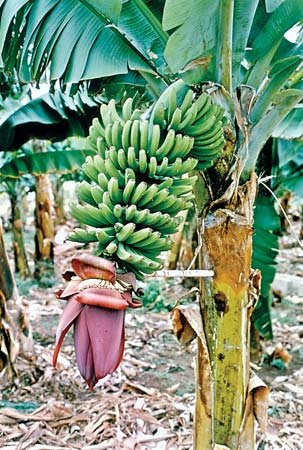Banana, fruit of the genus Musa, of the family Musaceae, one of the-main fruit plants of the world. The banana is grown in the tropics, and, though it is most broadly consumed in those regions, it is valued international for its flavour, nutritional price, and availability throughout the year. A ripe fruit contains as a lot as 22 percent of carbohydrate, most often as sugar, and is high in dietary fibre, potassium, manganese, and nutrition B6 and C. Cavendish, or dessert, bananas are most mainly eaten contemporary, though they is also fried or mashed and chilled in pies or puddings. They can be used to flavour truffles, cakes, or breads. Cooking sorts, or plantains, are starchy as an alternative than sweet and are grown greatly as a staple meals source in tropical areas. Even though Cavendish bananas are via a ways probably the most-original sort imported by using nontropical nations, plantain varieties account for approximately 85 percent of all banana cultivation global.

The banana plant is a giant herb that springs from an underground stem, or rhizome, to form a false trunk 3–6 metres (10–20 feet) high. This trunk consists of the basal parts of leaf sheaths and is crowned with a rosette of 10 to twenty oblong to elliptic leaves that often obtain a size of three–3.5 metres (10–11.5 feet) and a breadth of 65 cm (26 inches). A large flower spike, carrying numerous yellowish flowers protected via massive purple-purple bracts, emerges at the prime of the false trunk and bends downward to end up bunches of fifty to one hundred fifty individual fruits, or fingers. The person fruits, or bananas, are grouped in clusters, or fingers, of 10 to twenty. After a plant has fruited, it's slash to the ground, due to the fact each and every trunk produces just one bunch of fruit. The useless trunk is changed by way of others in the form of suckers, or shoots, which arise from the rhizome at roughly six-month intervals. The life of a single rhizome thus continues for decades, and the weaker suckers that it sends up through the soil are periodically pruned, at the same time the greater ones are allowed to develop into fruit-producing crops.

Banana vegetation thrive naturally on deep, free, good-drained soils in humid tropical climates, and they're grown successfully under irrigation in such semiarid areas as southern Jamaica. Suckers and divisions of the rhizome are used as planting fabric; the first crop ripens within 10 to fifteen months, and thereafter fruit creation is kind of steady. Generic pruning is required to get rid of surplus progress and preclude crowding in a banana plantation. Fascinating business bunches of bananas consist of nine arms or more and weigh 22–sixty five kg (49–143 kilos). 300 or extra such bunches is also produced annually on one acre of land and are harvested earlier than they absolutely ripen on the plant. For export, the preferred degree of maturity attained before harvest depends upon distance from market and type of transportation, and ripening is most commonly brought about artificially after cargo by exposure to ethylene fuel.

Bananas are notion to had been first domesticated in southeast Asia, and their consumption is recounted in early Greek, Latin, and Arab writings; Alexander the fine saw bananas on an expedition to India. Quickly after the discovery of the usa, bananas have been taken from the Canary Islands to the new World, where they have been first situated in Hispaniola and soon spread to different islands and the mainland. Cultivation extended until bananas grew to be a staple foodstuff in lots of regions, and within the 19th century they started to show up within the markets of the USA.
Although there are hundreds of thousands of kinds of bananas in cultivation, their taxonomy has been contentious in view that of their historical domestication, sterility, hybridization, and the use of various normal names to refer to the same form. As most cultivated varieties of bananas are both interspecific hybrids of Musa acuminata and M. Balbisiana or hybrids of the subspecies of M. Acuminata, a genome-established method has resulted in an overhaul of the nomenclature of domesticated bananas. Unlike most vegetation, these types are recognized by their ploidy (number of sets of chromosomes) and dad or mum plant as a substitute than ordinary binomial designations. A process of letters (“A,” “B,” or “AB”) represents the guardian plant(s), with a given letter repeated to indicate the ploidy. The fashionable Cavendish, for example, is known as AAA ‘Dwarf Cavendish,’ where “AAA” signifies its triploidy (three sets of chromosomes) as good as its derivation from M. Acuminata.
Considering the fact that every banana form is propagated clonally, there may be very little genetic diversity within the domesticated plants. This makes bananas in particular liable to pests and ailments, as a novel pathogen or pest might speedily decimate a sort if it were to take advantage of a genetic weakness among the clones. Certainly, this very phenomenon passed off within the late 1950s with the Gros Michel dessert form, which had dominated the world’s industrial banana business. Richer and sweeter than the latest Cavendish, the Gros Michel fell victim to an invading soil fungus that explanations Panama ailment, a type of Fusarium wilt. Powerless to breed resistance into the sterile clones and unable to rid the soil of the fungus, farmers were quickly pressured to abandon the Gros Michel in favour of the hardier Cavendish. Despite the fact that the Cavendish has as a result some distance been immune to this type of pestilent invasion, its lack of genetic diversity leaves it equally liable to evolving pathogens and pests. Indeed, a stress of Panama disorder referred to as Tropical Race (TR) 4 has been a chance to the Cavendish considering the fact that the 1990s, and lots of scientists fear that the Cavendish too will ultimately go extinct.